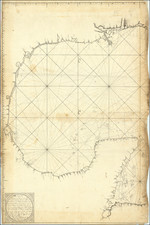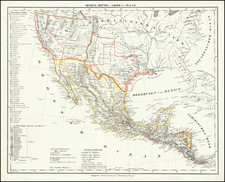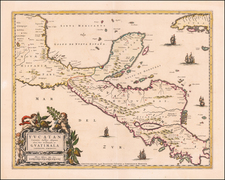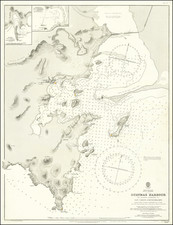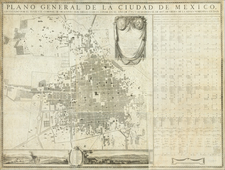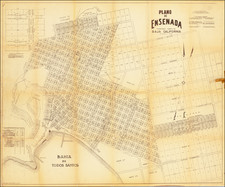Aztec Calendar Months and Festivals
A visually stunning original early 19th-century watercolor depicting several Aztec deities. Based on the Codex Telleriano Remensis, the deities shown are connected to specific festivals or representations of months in the Aztec calendar. The watercolor drawing was created by Capt. William H. Shippard, a British artist who was also a pioneer researcher of early Mexican civilizations. Each of the five figures has identifying annotations in Shippard's distinctive handwriting, including references to the Codex Telleriano Remensis and to Agostino Aglio, the artist who produced the lithographs for Lord Kingsborough's massive collection of Aztec codices: Mexican Antiquities:
Codex Telleriano Remensis preserved in the Royal Library at Paris. Aglio Mexican Antiquities. Vol. 1st.
The figures shown in the watercolor, all brilliantly colored are as follows:
- Panquetzalitzli (XV): Fifteenth month of the Aztec calendar, also a festival dedicated to Huitzilopochtli.
- Atemoztli (XVI) : Sixteenth month of the Aztec calendar, also a festival dedicated to Tlaloc, god of rain or water.
- The Five Dead Days (Nemontemi, or "extra days") - centerpiece of the sheet. Represents the "five dead days on which there were no sacrifices."
- Tititl (XVII): Festival of weaving.
- This feast was an observation of Ilama tecutli. The person imitating her (ixiptla) wore a white skirt (cueitl) and a white shift (huipilli). Over this she wore a star skirt (citlalli icue) with small seashells that jingled. Her sandals had white toes, woven with cotton threads. She had a shield (chimalli) covered with white clay and pasted over with eagle feathers and heron feathers, and in her other hand she held a weaving stick (tzotzopaztli). - Fr. Bernardino de Sahagún. Florentine Codex: General History of the Things of New Spain, Book 2 -- The Ceremonies, no. 14, Part III, translated by Arthur J. O. Anderson and Charles E. Dibble (Santa Fe and Salt Lake City: School of American Research and the University of Utah, 1951), 143.
- Yzcalli [Izcalli] (XVIII): Eighteenth and last month of the Aztec calendar, and a festival related to Xiuhtecuhtli, the fire god. A feast of rejuvenation.
- ....black line at the eye, painted black jaw, blue costume, blue stepped chest ornament, blue ear pegs... define this figure as an impersonator of the patriarchal old fire god Xiuhtecuhtli. The emphasison the color blue relates to his name, Turquoise Lord. The yellow skin and hair may be related to his role as a fire god, or they may allude to his other name and aspect, Ixcozauhqui (Yellow Face) - Quiñones Keber.
William Henry Shippard's Mexican Paintings
William H. Shippard (1803-1865) was a pioneering 19th-century British museologist - an unsung progenitor of modern-day museum anthropology. While he is chiefly remembered as a friend of George Catlin, Shippard's profound interest in the ancient civilizations of Mexico connects him with a cohort of British contemporaries that include Lord Kingsborough and the showman William Bullock. Shippard's fascination with Mesoamerica propelled him to amass a significant collection of visual material derived from Aztec codices which he copied himself. A figure of some intrigue and scholarly ambition, Shippard endeavored to establish the Museum of Mankind in London, which seems to have evolved from his deep interest in early Mexican cultures. Although the museum did not come to fruition, Shippard's original artwork, mainly pen and ink drawings enriched with vibrant hand coloring, based on Mexican codices held in European libraries and collections, remains a valuable historical source, particularly for understanding the allure of Mexican antiquity within early 19th-century British collecting circles.
Capt. William H. Shippard, a friend of George Catlin and an avid watercolorist and museologist, was also a pioneering British Mesoamericanist. Shippard appears in British newspaper notices from the 1840s as a London-based lecturer who spoke about Native Americans and Mexican antiquities. We know he was a friend of George Catlin, and that he was involved in attempts to organize early London museum exhibitions of Mexican antiquities. In the latter efforts Shippard would seem to coincide with a group of like minded prominent English collectors interested in Mexican topics active during the 1820s and 1830s, including Lord Kingsborough and the bibliomaniac Sir Thomas Phillipps, among others. He seems to have been an armchair anthropologist and would-be museum founder, whose ambitious ideas for a London-based museum never got off the ground - at least not beyond the prospectus-printing stage. Certain aspects of Shippard's career are akin to William Bullock, the showman and connoisseur of Mexican antiquities who actually did travel to Mexico. Bullock published a notable book about his Mexican travels, and achieved a level of recognition in his day as the empresario of London's Egyptian Hall, wherein he thrilled large London audiences with his elaborate exhibitions of exotica, including Mexican items.









